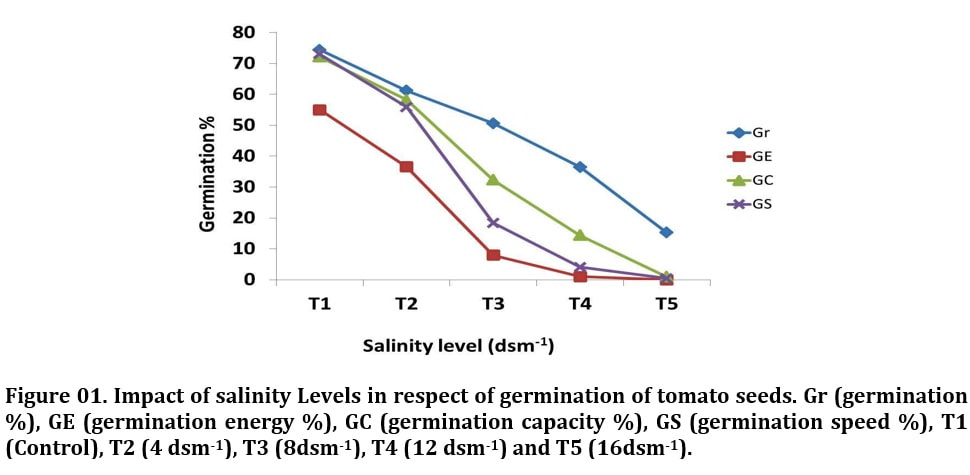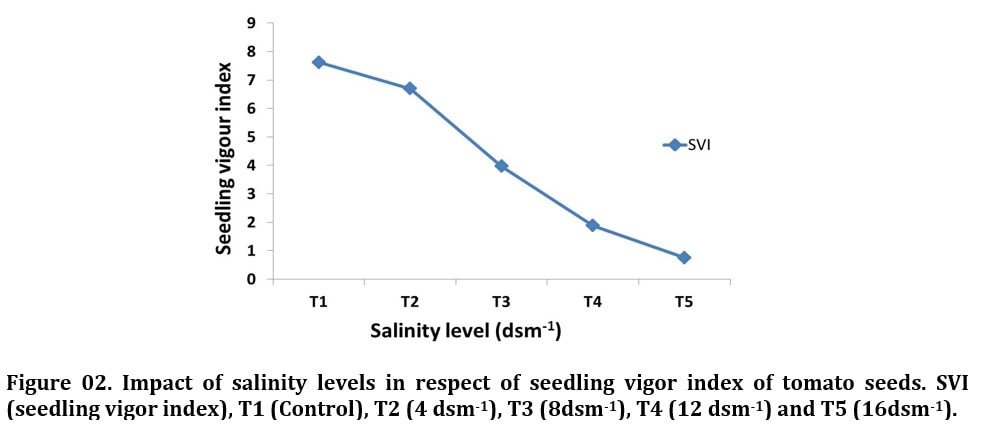J. Biosci. Agric. Res. | Volume 21, Issue 01, 1737-1748 | https://doi.org/10.18801/jbar.210119.212
Article type: Research article | Received: 19.02.2018, Revised: 10.05.2019, Date of Publication: 25 May 2019.
Article type: Research article | Received: 19.02.2018, Revised: 10.05.2019, Date of Publication: 25 May 2019.
Impact of salinity on seed germination and seedling growth of tomato
Shamima Nasrin and Md. Abdul Mannan
Agrotechnology Discipline, Khulna University, Khulna-9208, Bangladesh.
Corresponding Author: [email protected] (Shamima Nasrin).
Agrotechnology Discipline, Khulna University, Khulna-9208, Bangladesh.
Corresponding Author: [email protected] (Shamima Nasrin).
Abstract
Salinity reduces tomato seed germination and lengthens the time needed for germination. The seed rate will be increase in the soils where the electrical conductivity (EC) of a saturated extract was equal to or above 8 dS m−1. A study was conducted using fifteen genetically diverse genotypes under normal and salt stress conditions. The tomato genotypes were; 8 BARI varieties (BARI tomato-2, BARI tomato-8, BARI tomato-14, BARI tomato-15, BARI tomato-16, BARI tomato-17, BARI tomato-18 and BARI tomato-19) and 7 local varieties (Bonkim Ruby, Pusa Ruby, Suraksa, Patharkuchi, Ruma VF, Ruma 19 and Guli) were used as plant material. Although, tomato (Lycopersicon esculentum Mill.) was moderately sensitive to salinity but more attention to salinity is yet to be required in the production of tomato. In present study, germination (%), speed of germination, germination energy, germination capacity, seedling vigor index, fresh and dry weights of roots and root and shoot length, were the parameters assayed on five salinity levels. Increasing salt stress negatively affected germination and seedling growth. When salt concentration increased, germination of tomato seed was reduced and the time needed to complete germination lengthened. Among the varieties, BARI tomato 14 and BARI tomato 15 were found to be the more tolerant genotypes in the present study based on studied parameters.
Key Words: Salinity, Seeds, Germination, Seedling growth and Tomato
Salinity reduces tomato seed germination and lengthens the time needed for germination. The seed rate will be increase in the soils where the electrical conductivity (EC) of a saturated extract was equal to or above 8 dS m−1. A study was conducted using fifteen genetically diverse genotypes under normal and salt stress conditions. The tomato genotypes were; 8 BARI varieties (BARI tomato-2, BARI tomato-8, BARI tomato-14, BARI tomato-15, BARI tomato-16, BARI tomato-17, BARI tomato-18 and BARI tomato-19) and 7 local varieties (Bonkim Ruby, Pusa Ruby, Suraksa, Patharkuchi, Ruma VF, Ruma 19 and Guli) were used as plant material. Although, tomato (Lycopersicon esculentum Mill.) was moderately sensitive to salinity but more attention to salinity is yet to be required in the production of tomato. In present study, germination (%), speed of germination, germination energy, germination capacity, seedling vigor index, fresh and dry weights of roots and root and shoot length, were the parameters assayed on five salinity levels. Increasing salt stress negatively affected germination and seedling growth. When salt concentration increased, germination of tomato seed was reduced and the time needed to complete germination lengthened. Among the varieties, BARI tomato 14 and BARI tomato 15 were found to be the more tolerant genotypes in the present study based on studied parameters.
Key Words: Salinity, Seeds, Germination, Seedling growth and Tomato
Article Full-Text PDF
| 212.01.21.19_impact_of_salinity_on_seed_germination_and_seedling_growth_of_tomato.pdf | |
| File Size: | 972 kb |
| File Type: | |
Article Metrics
|
Share This Article
|
|
Article Citations
MLA
Nasrin and Mannan. “Impact of salinity on seed germination and seedling growth of tomato.” Journal of Bioscience and Agriculture Research 21(01) (2019): 1737-1748.
APA
Nasrin, S. and Mannan, M. A. (2019). Impact of salinity on seed germination and seedling growth of tomato. Journal of Bioscience and Agriculture Research, 21(01), 1737-1748.
Chicago
Nasrin, S. and Mannan, M. A. “Impact of salinity on seed germination and seedling growth of tomato.” Journal of Bioscience and Agriculture Research 21(01) (2019): 1737-1748.
Harvard
Nasrin, S. and Mannan, M. A. 2019. Impact of salinity on seed germination and seedling growth of tomato. Journal of Bioscience and Agriculture Research, 21(01), pp. 1737-1748.
Vancouver
Nasrin, S and Mannan, MA. Impact of salinity on seed germination and seedling growth of tomato. Journal of Bioscience and Agriculture Research. 2019 May 21(01): 1737-1748.
Nasrin and Mannan. “Impact of salinity on seed germination and seedling growth of tomato.” Journal of Bioscience and Agriculture Research 21(01) (2019): 1737-1748.
APA
Nasrin, S. and Mannan, M. A. (2019). Impact of salinity on seed germination and seedling growth of tomato. Journal of Bioscience and Agriculture Research, 21(01), 1737-1748.
Chicago
Nasrin, S. and Mannan, M. A. “Impact of salinity on seed germination and seedling growth of tomato.” Journal of Bioscience and Agriculture Research 21(01) (2019): 1737-1748.
Harvard
Nasrin, S. and Mannan, M. A. 2019. Impact of salinity on seed germination and seedling growth of tomato. Journal of Bioscience and Agriculture Research, 21(01), pp. 1737-1748.
Vancouver
Nasrin, S and Mannan, MA. Impact of salinity on seed germination and seedling growth of tomato. Journal of Bioscience and Agriculture Research. 2019 May 21(01): 1737-1748.
References
- Abdul. A. A. and Anderson, J. D. (1973). Vigor Determination in soybean seed by multiple criteria. Crop Sci. 1(3), 630– 633. https://doi.org/10.2135/cropsci1973.0011183X001300060013x
- Akinci, I. E. Akinc S. I. Yilmaz K. and Dikici, H. (2004). Response of eggplant varieties (Solanum melongena) to salinity in germination and seedling stages. New Zealand Journal of Crop and Horticultural Science, 32(2), 193-200. https://doi.org/10.1080/01140671.2004.9514296
- Al-Karaki, G. N. (2000). Growth, water use efficiency, and sodium and potassium acquisition by tomato cultivars grown under salt stress. Journal of Plant Nutrition, 23, 1-8. https://doi.org/10.1080/01904160009381992
- Amir, N. Muhammad, A. Muhammad, A. P. and Irfan, A. (2011). Effect of halo priming on germination and seedling vigor of tomato. African Journal of Agricultural Research, 6(15), 3551–3559.
- Bam, R. K. Kumaga, F. K. Ofori, K. and Asieudu, E. A. (2006). Germination, vigor and dehydrogenase activity of naturally aged rice (Oryza sativa L.) seeds soaked in potassium and phosphorous salts. Asian Journal of Plant Science, 5, 948–955. https://doi.org/10.3923/ajps.2006.948.955
- Bhattacharjee, S. (2008). Triadimefon pretreatment protects newly assembled membrane system and causes upregulation of stress proteins in salinity stressed Amaranthus lividus L. during early germination. Journal of Environment Biology, 29, 805-810.
- Croser, C. Renault, S. Franklin, J. and Zwiazk, J. (2001). The effect of salinity on the emergence and seedling growth of picea mariana, Picea Glanca and Pinus barksiana. Environmental Pollution, 115, 6–16. https://doi.org/10.1016/S0269-7491(01)00097-5
- Cuartero, J. and Munoz, R. F. (1999). Tomato and salinity. Scientia Horticulture, 78, 83–125. https://doi.org/10.1016/S0304-4238(98)00191-5
- Delachiave, M. E. A. and dc Pinho, S. Z. (2003). Scarification, temperature and light in germination of Senna cccidentalis seed (Caesalpinaceae). Seed Science and Technology, 31(2), 225-230. https://doi.org/10.15258/sst.2003.31.2.01
- Essa, A. T. and Al-Ani, D. H. (2001). Effect of salt stress on the performance of six soybeangenotypes. Pakistan Journal of Biological Science, 4, 175–177. https://doi.org/10.3923/pjbs.2001.175.177
- Estan, M. T. Martinez–Rodriguez, M. M. Perez–Alfocea, F. Flowers, T. J. and Bolarin, M. C. (2005). Grafting raises the salt tolerance of tomato through limiting the transport of sodium and chloride to the shoot. Journal of Experimental Botany, 56(412), 703-712.https://doi.org/10.1093/jxb/eri027
- Fernandez-Garcia, N. Martinez, V. Cerdá, A. and Carvajal, M. (2004). Fruit quality of grafted tomato plants grown under saline conditions. Journal of Horticultural Science and Biotechnology, 79(6), 995-1001. https://doi.org/10.1080/14620316.2004.11511880
- Gomez, K. A. and Gomez, A. A. (1984). Statistical Procedures for Agricultural Research (2nd Ed.). John Wiley and Sons, New York. pp. 1-340.
- Groot, S. P. C. and Karssen, C. M. (1992). Dormancy and germination of abcissic acid deficient tomato seeds.Plant Physiology, 99, 952–958. https://doi.org/10.1104/pp.99.3.952
- Groot, S. P. C. Kieliszewska-Rokicka, B. Vermeer, E. and Karssen, C. M.(1988). Giberellin induced hybrolysis of endosperm cell walls in giberellin deficient tomato seeds prior to radicle protrusion. Planta, 174, 500–504.
- Hajer, A. S. Malibari, A. A. Al-Zahrani, H. S. and Almaghrabi, O. A. (2006). Responses of three tomato cultivars to seawater salinity, 1.Effect of salinity on the seedling growth. African Journal of Biotechnology, 5(10), 855-861.
- Hakim, M. A. Juraimi, A. S. Begum, M. Hanafi, M. M. Ismail, M. R. and Selamat, A. (2010). African Journal of Biotechnology, 9(13), 1911-1918. https://doi.org/10.3923/ja.2010.9.16
- Hamed, K. Hossein, N. Mohammad, F. and Safieh, V. J. (2011). How salinity affect germination and emergence of tomato lines. Journal of Biodiversity and Environmental Sciences, 5(15), 159–163.
- Jamil, M. Lee, C.C. Rehman, S. U. Lee, D. B. Ashraf, M. and Rha, E. S. (2005). Salinity (NaCI) tolerance of brassica species at germination and early seedling growth. Electro. J. Environ. Agric. Food Chem, 7, 116-121.
- Kazemi, E. M. Jonoubi, P. Pazhouhandeh, M. Majd, A. and Aliasgharpour, M. (2014). Response of variable tomato (solanum lycopersicum mill.) genotypes to salinity at germination and early seedling growth stages, International Journal of Plant, Animal and Environmental Sciences, 4(2), 605-612.
- Hosseini, K., M. Powell, A. A. and Bingham, I. J. (2003). Seed Sciences Technology, 31, 715-725. https://doi.org/10.15258/sst.2003.31.3.20
- Krishnaswamy, V. and Seshu, D. V. (1990). Germination after ccelerate aging associated characters in rice varieties. Seed Science and Technology, 8, 147–150.
- Maggio, A. Raimondi, G. Martino, A. and De Pascale, S. (2007). Environmental and Experimental Botany, 59, 276–282. https://doi.org/10.1016/j.envexpbot.2006.02.002
- Mariko, S. Kachi, N. Ishkawa, S. and Furukawa, A. (1992). Germination ecology of coastal plants in relation to salt environment. Ecological Research, 7, 225-233. https://doi.org/10.1007/BF02347091
- Parida, A. K. and Das, A. B. (2005). Salt tolerance and salinity effects on plants. Ecotoxicology and Environmental Safety, 60, 324-349. https://doi.org/10.1016/j.ecoenv.2004.06.010
- Santa-Cruz, A, Martinez-Rodriguez, M. M. Perez-Alfocea, F. Romero-Aranda, R. and Bolarin, M. C. (2002). The rootstock effect on the tomato salinity response depends on the shoot genotype. Plant Science, 162(5), 825-831. https://doi.org/10.1016/S0168-9452(02)00030-4
- Shannon, M. C. Gronwald, J. W. and Tal, M. (1987). Effect of salinity on growth and accumulation of organic and inorganic ions in cultivated and wild tomato species. Journal of American Horticultura Science, 112, 516-523.
© 2019 The Authors. This article is freely available for anyone to read, share, download, print, permitted for unrestricted use and build upon, provided that the original author(s) and publisher are given due credit. All Published articles are distributed under the Creative Commons Attribution 4.0 International License.
Journal of Bioscience and Agriculture Research EISSN 2312-7945.


